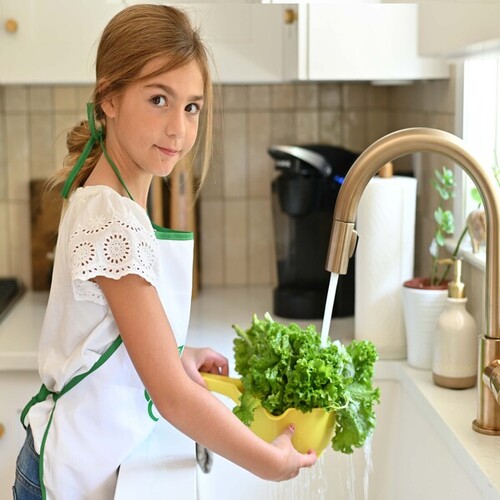
Why Wash Fruits & Veggies?
Do you know where your lettuce was grown and why it should be washed?
How many hands have touched the head of lettuce that is in your salad? Let’s look at the process that brought a commercially sold head of lettuce from the farm to your table.
- Farm—The lettuce is harvested, placed in containers, and transported to a packing house to prepare it for shipping.
- Processing center—The lettuce is received, inspected, cleaned, and assessed for quality. A record is created to identify the grower, supplier, date of harvest, and all production notes to trace the produce for transport. The lettuce is packaged to protect it and add product branding for market. Depending on its use and retail destination, the lettuce may be placed in bags, bulk bins, cartons, and/or palletized containers. The lettuce is now ready to ship.
- Transport—The packaged lettuce is transported to the distributor on planes, trains, and trucks—depending on distance and whether it is domestically grown or imported. Lettuce containers must be temperature controlled and loaded in an accessible way to get fresh-picked produce to the shelf as quickly as possible.
- Store—The containers of lettuce are unloaded at the store, removed from boxes, and placed on shelving for sale.
- Home—The customer puts the lettuce in a shopping cart and unloads it at checkout, where it is bagged, and then brings it home.
In this process, no fewer than ten sets of hands have touched the lettuce in your salad. A head of lettuce can travel more than 1,500 miles to get to your plate. The more hands that touch the produce, the higher the contamination risk. Even in your home, contamination can occur if food is not stored properly.
Taking a few minutes to wash produce can ensure that food is clean and safe to eat. Washing will help remove bacteria, including E. coli, from the surfaces of fruits and vegetables. Washing loose produce is particularly important, because it tends to have more soil attached to it than pre-packaged fruits and vegetables do. Peeling or cooking fruits and vegetables can also remove bacteria.
Make sure you rinse produce before you peel it, so dirt and bacteria aren’t transferred from the knife onto the fruit or vegetable. Gently rub produce while holding it under running water. Do not use soap or a produce wash. A clean vegetable brush will help to scrub firm produce, but two hands are all you really need to carefully clean the produce.
What if the bag of salad is already washed? Many producers wash their greens before they bag them. This lettuce is pre-cut, pre-washed, and ready to eat. If it is labeled as such, the FDA has confirmed you can use the produce without further washing.
